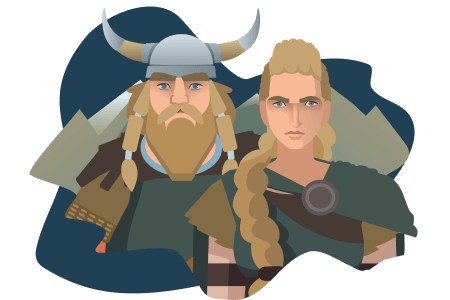The Viking Age occurred from about 750 C.E. to 1050 C.E.
This altered the political, cultural and demographic map of Europe in ways that are still evident today in place names, surnames and modern genetics.
The word Viking comes from the Scandinavian term "vikingr" meaning "pirate".
Is there a such thing as "Viking DNA"?
Not really. It's like saying there is "plumber DNA" or "engineer DNA"; "Viking" is a job description.
Being a Viking meant one went on long distance trading expeditions with a bit of armed robbery on the side- it was a risky job, but the poverty of northern Europe at the time made it look like a viable option.
Anyone could go "a-viking', Slavs and Balts did it against the Scandinavians, the Irish were doing it before the Scandinavians with their raids on Britain in the 6th-7th centuries and the Saxons against the Roman province of Britannia in the 5th century. They just didn't call it that because they didn't speak Old Norse.
Where traces of Scandinavian DNA are found that look like they date to the medieval period, it was from settlers.
Eventually trading, going on smash and grab slaving raids or trying to extort protection money from the monarchs of Europe became less appealing than just colonizing territory overseas.
Former Vikings like Rollo, first Duke of Normandy, made a lot more money as a Frankish nobleman and did not have to risk his neck in the North Sea storms to do so.
Viking is an occupation/activity and occupations don't have DNA. However, the Norse who came to Britain and Ireland were often engaged in Viking activity.
Same with the Danes, some settled to farm, the Angles and Jutes did, they were INVITED to England to help bolster security and they came because they lost so much of their land due to the sea flooding, contaminating huge swathes of Denmark, but others were Vikings.
According to the DNA testing services that are pushing the "Viking Index" - Genomelink (the service I used), YourDNAguide, LivingDNA etc., I'm 64% on the scale of "Vikingness" in the top 10th percentile compared with all Genomelink users.

As I understand percentiles, if a person's DNA is in the 90th percentile of a group, they have more of that DNA than 90% of the group, putting them in the top 10%.
The other part of the test reveals that I'm most related to Norwegian Vikings.
This estimate is, in reality, a more "Are your ancestors genetically similar to Norwegian Vikings"?
The Viking Index is a relative score i.e. in comparison to the whole range of Viking Indexes across the sevice's user base.
In my case, this makes some sense only because I am directly descended from the Norman-French, both patrilineally and matrilineally.
These reports look similar to this Viking Product from Genomelink:
World's largest DNA sequencing of Viking skeletons reveals they weren't all Scandinavian (Margaryan et al., 2020).
Scientists raid DNA to explore Vikings' genetic roots (National Geographic, Blakemore, 2020).
Phil Grass, a genealogical researcher from Britain, writes "I find the idea that you are genetically connected to any group of ancient warriors is, at best, stupid and irrelevant and at worst creating a false connectively with ancestors who were killers, rapists and slave-traders."
Grass goes on, "It is similar to the Neanderthal results that other DNA tester, such as 23andMe, where I apparently have more Neanderthal DNA than 45% of other customers".